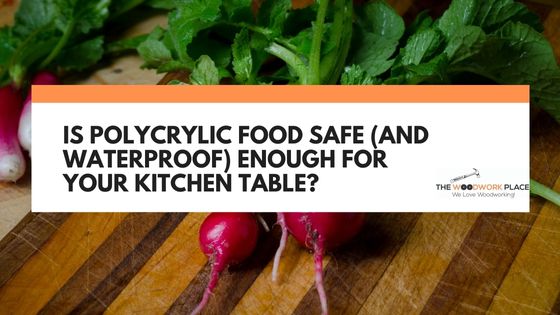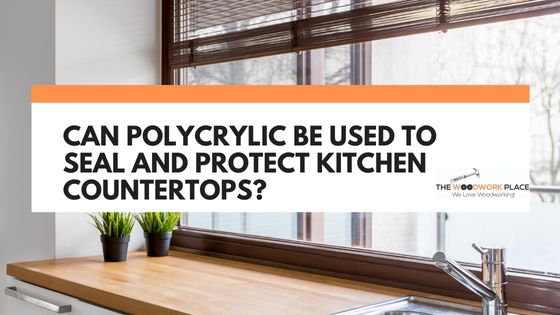Polycrylic is an easy to apply wood sealant that dries fast and safeguards wooden surfaces from scratches and scrapes. And like other water-resistant wood sealers, (such as polyurethane), it contains Urethane.
And what is Urethane? Well, it is the key ingredient that allows these top coating finishes to prevent moisture from getting into the wood underneath.
Still, can a few coats of Polycrylic be enough to protect even exterior wooden surfaces?
Well, in this post, you will learn what makes Polycrylic stand apart from other water-based finishes. You will also find out whether Polycrylic is water-resistant enough for the great outdoors.
And keep reading to discover which urethane-based wood sealant is the best and most weatherproofing way to protect outdoor furniture.
This post may contain affiliate links to products that we receive a commission for (at no additional cost to you). Learn more here.
What Can You Do To Weatherproof Wood And Make It Waterproof?
Your best option is to use a urethane-based sealer. The most waterproof urethane sealers prevent not only water damage, but also rot and decay.
Which is why something like Spar Urethane, (also known as Spar Varnish), is one of the best sealants you can use for outdoor wood. In fact, Spar Urethane is pretty much the gold-standard sealant for boats, marine-side structures, and outdoor decking.
You see, this waterproofing sealant not only contains urethane, it also contains UV blockers and mold-resistant additives.
So, not only does it prevent moisture from sinking into wood, it can prevent color fading, due to UV damage. And its mold-resistant additives can stop the growth of mold and mildew.
Another advantage to using Spar Urethane sealant is it’s durability. It is an incredibly low-maintenance sealer. So much so, that it can last up to 5 years before needing to be re-coated.
And What About Polycrylic? Is Polycrylic Good For Outdoor Wood Too?
Well, Polycrylic is a great crystal clear finish for interior wooden surfaces. So, it works great on bedside table tops, chairs, and cabinets.
It’s easy to apply, and easy to clean up. Especially since you only need warm water to wipe this finish off.
What’s more, it doesn’t release a lot of lung-burning fumes, (technically known as Volatile Organic Compounds), into the air.
Now, Polycrylic is a quick drying glossy interior wood finish. Still, you should avoid using it on wooden surfaces in rooms that have a lot of steam/humidity (laundry room, bathroom, etc).
This is because all of that high-humidity and thick steam can make its way past this wood sealant. Which is why Polycrylic isn’t suitable for outdoor wood either.
Related Post: Is Polycrylic Food Safe (And Waterproof) Enough For Your Kitchen Table?
So Does That Mean Polycrylic Can’t Protect And Waterproof Wood From Rain?
Here’s the thing; it is a good water-resistant finish for interior wooden surfaces. But the important word here is ‘interior’.
So, on one hand, it’s more water-resistant than natural wood finishes, such as Tung oil or Linseed oil. But, it’s not 100% waterproof. And if you where to leave a hot condensation-saturated mug atop this finish, it’ll damage this sealant.
This is the main reason why Polycrylic is ideal for interior wood, but a poor option for exterior timber. Between the humidity and rain of the great outdoors, Polycrylic won’t be enough to weatherproof wood.
Related Post: Can Polycrylic Be Used To Seal And Protect Kitchen Countertops?
Is Polycrylic The Same As Polyurethane? Or Is It A Different Type Of Sealant?
Polycrylic is a water-based acrylic/urethane blended wood finish from Minwax. So it can protect wood from water spills and scratches just as well as any other water-based polyurethane can.
And as a water-based sealer, it is a much thinner substance than oil-based finishes. But its low viscosity also allows Polycrylic to dry in a fraction of the time of oil-based polyurethanes.
And How Long Does It Actually Take Polycrylic To Dry And Cure?
It takes about 2 hours to dry in between multiple coats of this wood finish. And around 24 hours for it to cure.
Although, in humid/cold climates, it can take as much as 72 hours to wholly cure.
What About Durability? Which One Is Harder: Polyurethane Or Polycrylic?
Well, the comparison here is less about polyurethane vs Polycrylic. Instead, its more about comparing oil-based sealers verses water-based sealers.
Now, oil-based polyurethanes are a more durable finish than water-based polys. They sink down deeper into wood than water-based ones, and are even more heat-resistant too.
However, oil-based polyurethanes can look more ‘aged’ than water-based ones, due to the fact that they turn yellow over time. And they also take much longer to dry as well.
But, having said all that, the durability difference between comparing just oil-based and water-based isn’t that vast. Instead, the durability of a outdoor finish is more impacted by the additional ingredients that have been added to a specific brand.
For example, some polyurethanes have extra mildew-resistant fungicides and UV-blockers added to them. So, these polyurethane finishes, (whether water-based or oil-based), are going to be more durable and weatherproof.
To Wrap Up, Here Are The 3 Key Takeaways From This Post…
- 1). Polycrylic is a fast-drying water-based acrylic/urethane blended wood finish. It works like a water-based polyurethane, safeguarding wood from damage.
- 2). But it is not a wholly waterproof or weatherproof wood sealant. So it should only be used on interior wood.
- 3). If you want to protect and weatherproof exterior wood, use Spar Varnish. This urethane-based wood sealer is so water-resistant it can be used on outdoor furniture and boat decking.


![Help! Why Are There Air Bubbles In My Polycrylic Finish! [+ What You Can Do To Fix It] bubbles in polycrylic finish](https://www.thewoodworkplace.com/wp-content/uploads/2022/10/Banner-490.jpg)

